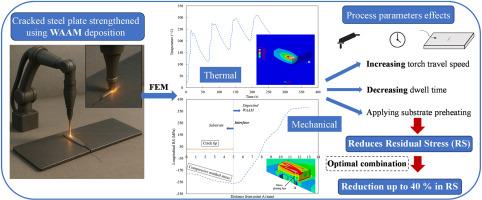裂纹钢板电弧增材强化工艺参数优化研究
IF 6.6
2区 材料科学
Q1 MATERIALS SCIENCE, MULTIDISCIPLINARY
Journal of Materials Research and Technology-Jmr&t
Pub Date : 2025-09-21
DOI:10.1016/j.jmrt.2025.09.167
引用次数: 0
摘要
电弧丝增材制造(WAAM)也被称为电弧丝定向能沉积(WA-DED),已成为修复和加强钢结构的一项有前途的技术。为了改善裂纹钢板的残余应力分布,提高裂纹钢板的结构完整性,研究了WAAM工艺中关键工艺参数的优化。建立并验证了热力学有限元模型来预测温度演变和RS曲线。在确定最佳停留时间类型之后,系统分析了行进速度、停留时间和衬底预热温度对热历史、WAAM/板界面处RS分布和外载荷下最大应力的影响。结果表明,增加行程速度可以有效降低拉伸残余应力,而延长停留时间会增加热梯度,从而导致残余应力和最大应力的增加。此外,基体预热显著降低了拉伸残余应力,但也降低了裂纹尖端附近的压应力,这可能会影响裂纹止裂效果。通过优化工艺参数组合,最大残余应力和外部载荷下的最大应力均降低了40%。这些发现为提高waam增强钢构件的疲劳性能和结构可靠性提供了有价值的见解。本文章由计算机程序翻译,如有差异,请以英文原文为准。

Optimization of process parameters in wire arc additive manufacturing for strengthening cracked steel plates: A thermo-mechanical study
Wire Arc Additive Manufacturing (WAAM) also known as wire arc-based directed energy deposition (WA-DED) has emerged as a promising technology for repairing and strengthening steel structures. This study investigates the optimization of key process parameters in the WAAM process to improve residual stress (RS) distribution and structural integrity of cracked steel plates. A thermo-mechanical finite element model is developed and validated to predict temperature evolution and RS profiles. Following determination of the optimal dwell time type, the effects of travel speed, dwell time, and substrate preheating temperature on thermal history, RS distribution at the WAAM/plate interface, and maximum stress under external loading are systematically analyzed. The results reveal that increasing travel speed effectively reduces tensile residual stresses, while extended dwell times lead to higher residual and maximum stresses due to increased thermal gradients. Additionally, substrate preheating significantly lowers tensile residual stresses but also reduces compressive stresses near the crack tip, which may influence crack arrest effectiveness. By optimizing the combination of process parameters, reductions of up to 40 % in both maximum residual stress and maximum stress under external loading were achieved. These findings provide valuable insights for enhancing the fatigue performance and structural reliability of WAAM-strengthened steel components.
求助全文
通过发布文献求助,成功后即可免费获取论文全文。
去求助
来源期刊

Journal of Materials Research and Technology-Jmr&t
Materials Science-Metals and Alloys
CiteScore
8.80
自引率
9.40%
发文量
1877
审稿时长
35 days
期刊介绍:
The Journal of Materials Research and Technology is a publication of ABM - Brazilian Metallurgical, Materials and Mining Association - and publishes four issues per year also with a free version online (www.jmrt.com.br). The journal provides an international medium for the publication of theoretical and experimental studies related to Metallurgy, Materials and Minerals research and technology. Appropriate submissions to the Journal of Materials Research and Technology should include scientific and/or engineering factors which affect processes and products in the Metallurgy, Materials and Mining areas.
 求助内容:
求助内容: 应助结果提醒方式:
应助结果提醒方式:


